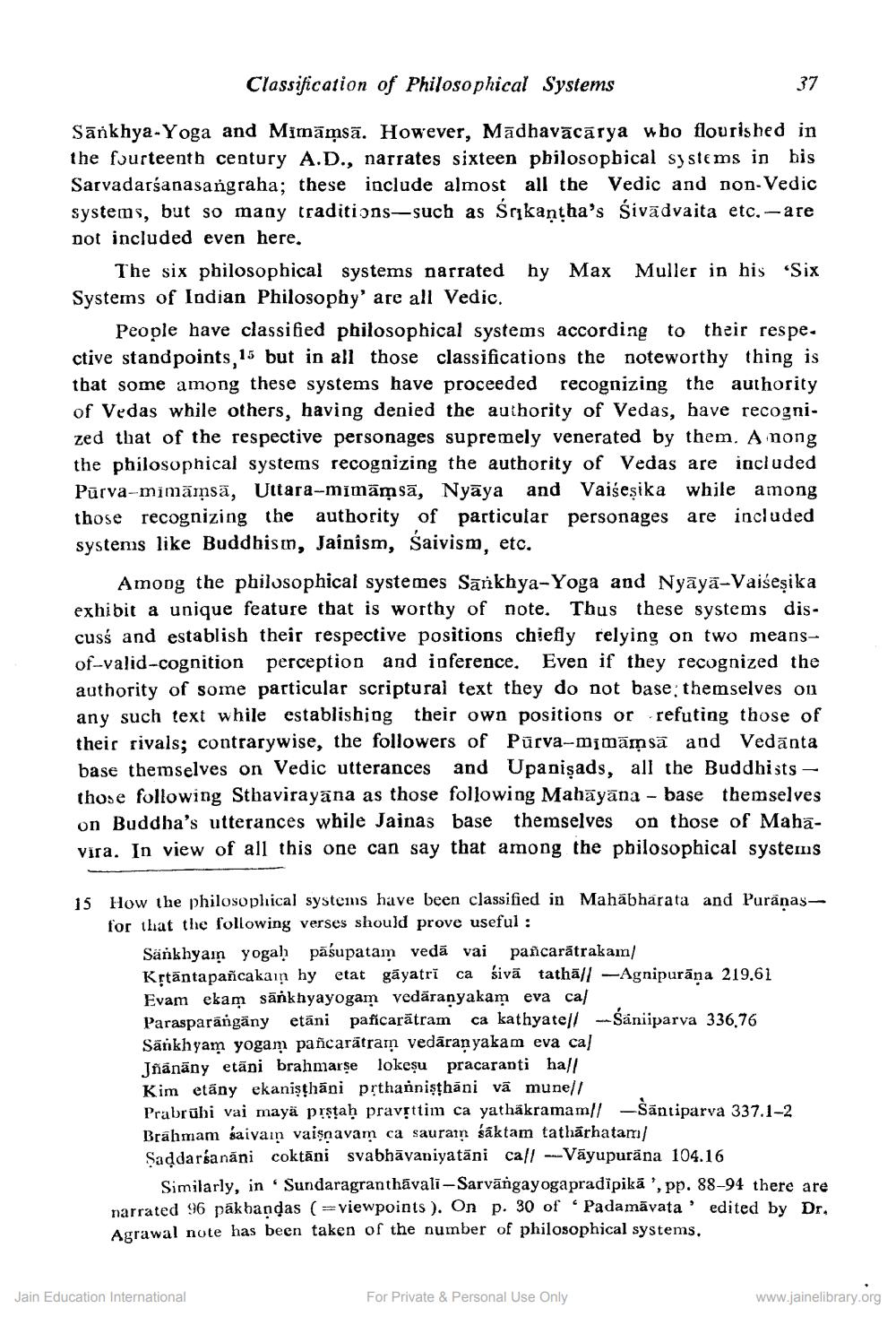________________
Classification of Philosophical Systems
37
Sankhya-Yoga and Mimämsä. However, Madhavacārya who flourished in the fourteenth century A.D., narrates sixteen philosophical systems in his Sarvadarśanasangraha; these include almost all the Vedic and non-Vedic systems, but so many traditions-such as Śrkantha's Śivadvaita etc.-are
not included even here.
hy Max Muller in his 'Six
People have classified philosophical systems according to their respe ctive standpoints, 15 but in all those classifications the noteworthy thing is that some among these systems have proceeded recognizing the authority of Vedas while others, having denied the authority of Vedas, have recognized that of the respective personages supremely venerated by them. A nong the philosophical systems recognizing the authority of Vedas are included Pūrva-mimāmsā, Uttara-mimāmsā, Nyaya and Vaiseṣika while among those recognizing the authority of particular personages are included systems like Buddhism, Jainism, Saivism, etc.
The six philosophical systems narrated Systems of Indian Philosophy' are all Vedic.
Among the philosophical systemes Sankhya-Yoga and Nyāyā-Vaiseṣika exhibit a unique feature that is worthy of note. Thus these systems discuss and establish their respective positions chiefly relying on two meansof-valid-cognition perception and inference. Even if they recognized the authority of some particular scriptural text they do not base; themselves on any such text while establishing their own positions or refuting those of their rivals; contrarywise, the followers of Purva-mimāmsa and Vedanta base themselves on Vedic utterances and Upanisads, all the Buddhists - those following Sthavirayana as those following Mahayana - base themselves on Buddha's utterances while Jainas base themselves on those of Mahavira. In view of all this one can say that among the philosophical systems
15
How the philosophical systems have been classified in Mahabharata and Puranasfor that the following verses should prove useful:
Sänkhyan yogaḥ pasupatam veda vai pañcarātrakam/
Kṛtäntapañcakain hy etat gayatri ca siva tatha// Agnipurana 219.61 Evam ekam sänkhyayogam vedaranyakam eva ca/
Parasparängäny etani paficarãtram ca kathyate// Śaniiparva 336,76 Sänkhyam yogam pañcaratram vedaraṇyakam eva cal Jñänäny etani brahmarṣe lokeşu pracaranti ha// Kim etäny ekaniṣṭhāni pṛthannisthäni va mune//
Prabruhi vai maya prstaḥ pravṛttim ca yathakramam// -Santiparva 337.1-2 Brahmam saivain vaisnavam ca sauram saktam tatharhatam/
Saḍdarśanani coktāni svabhavaniyatāni ca// ---Vayupurana 104.16
Similarly, in Sundaragranthāvali-Sarvangayogapradipikā ', pp. 88-94 there are narrated 96 pakbandas (=viewpoints). On p. 30 of Padamavata Agrawal note has been taken of the number of philosophical systems.
edited by Dr.
Jain Education International
For Private & Personal Use Only
www.jainelibrary.org




